The BMW GS is the bike that saved BMW Motorrad from the axe a little over 40 years ago, so its importance to the company is impossible to overstate. For much of this time, the GS stood alone as the sole maxi-ADV, but times have indeed changed, and the GS faces more competition than ever from a consistently growing list of manufacturers.
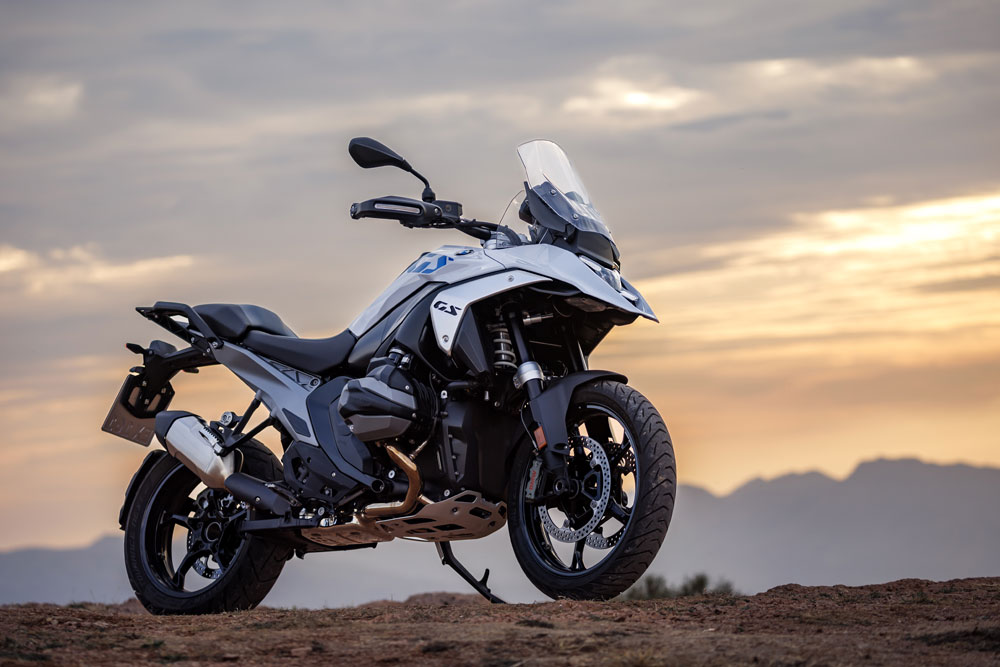
By Rennie Scaysbrook
Thus, the 2024 BMW R 1300 GS represents a milestone in the model’s life. Expanded from 1254cc to bang-on 1300cc, the GS has never been more powerful and never offered such a dizzying array of technical advancements to the consumer.
The first production motorcycle to come to market with Front Collision Warning (FCW) and now sporting radar-adaptive cruise control and blind spot detection, the GS is firmly back at the top of the tech game. It’s wrapped up neatly in a brand-new chassis, completely reworked suspension, and new, smaller ergonomics that make the outgoing R 1250 GS—one of our favorite bikes here at Cycle News—feel like a tank. This is going to be a big test, so grab a coffee and block out the next half hour of your life, and I’ll tell you all about it.
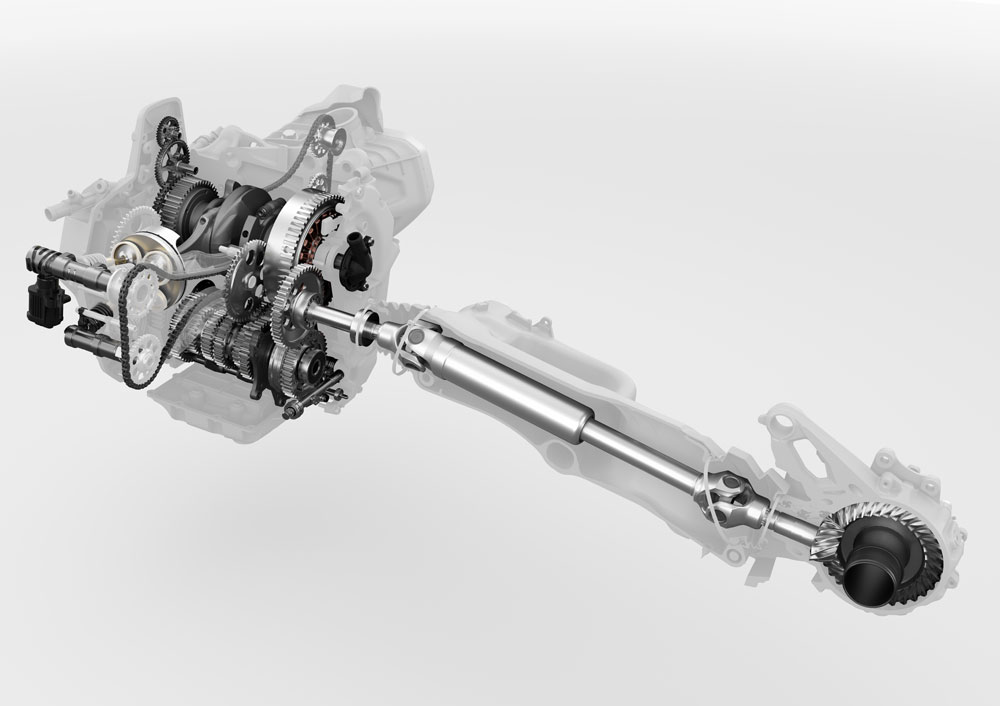
Seven Long Years | 2024 BMW R 1300 GS Review
That’s how long the new GS has been in development. Seven years! In that time, BMW released a new line of cruisers, a new electric scooter line, debuted M-spec superbikes and naked bikes, and even gave the 1250 a facelift in 2018.
There are only two part numbers carried over from the R 1250 GS, not including the throttle bodies. Everything else is new and can’t be swapped over. But rather than pursue the narrative of maxi-ADVs getting bigger with every passing generation, BMW’s brief to its designers was to make it smaller in every aspect while still getting the most performance possible.
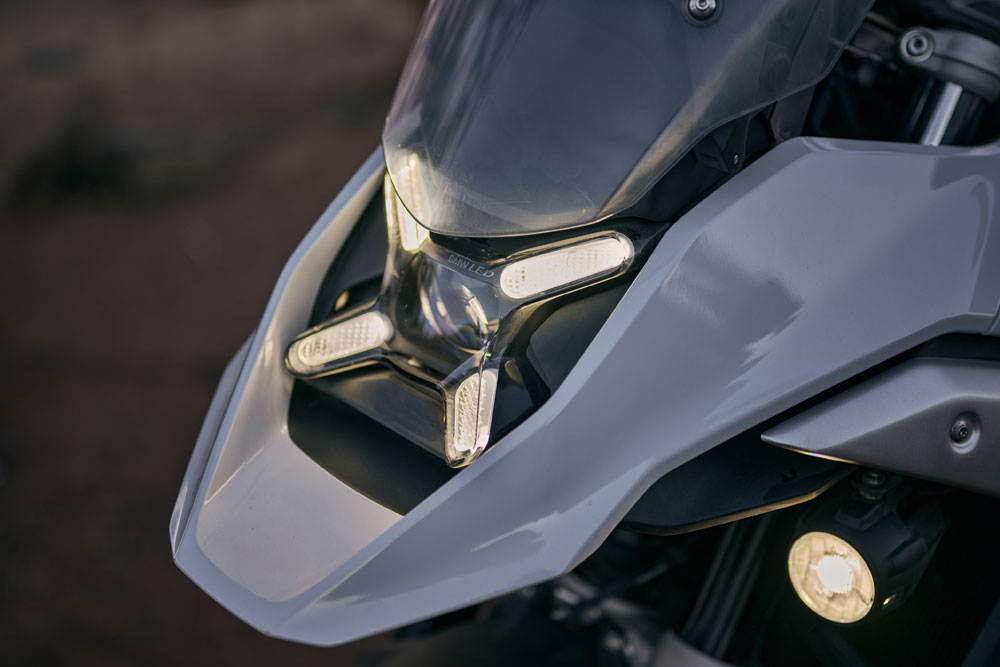
“We were thinking, what could we really change in the general technical concept?” says Christian Hahn-Woernle of BMW Motorrad’s Design team. “And we finally came up with a combination of two concepts which are normally rivals and don’t really work with each other—integration and modularity. In terms of integration, first of all, we take all the critical, essential parts and try to arrange and package them in the most efficient way possible to create this small bike. But we also designed each of these parts, especially for this very bike and for this very purpose.
“In terms of modularity, we had to design the bike so that each part works all together. So that means if you take any part of this parcel away, the whole thing will fall to pieces. Or the other way around, if you would take any of these pieces, you couldn’t fit it onto another bike. This was a different approach compared to the 1250 GS, which was more a conglomerate of devices.”
A look at the R 1250 GS and new R 1300 GS side-by-side confirms this approach. The 1300 is dramatically slimmer in almost every area—from the front beak housing a new all-in-one X-shaped headlight to the skinnier tank and eye-catching cast aluminum tail section, nothing has been untouched by the designer’s pen.
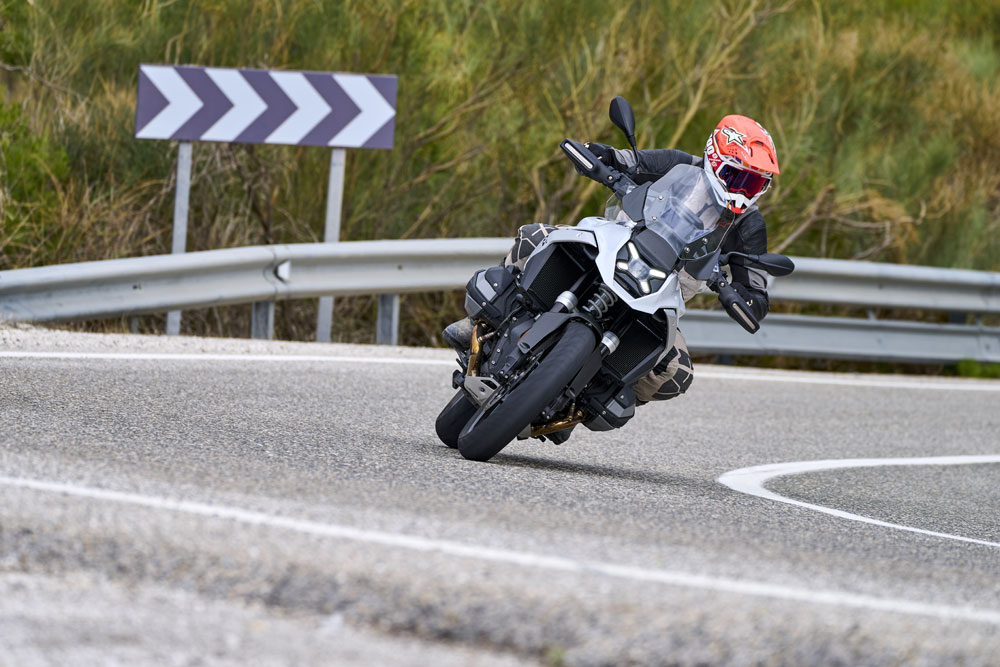
Slim It Down | 2024 BMW R 1300 GS Review
There are many aspects as to why this is, but the biggest and most obvious comes from the new motor. Now, the GS engine has its six-speed gearbox mounted underneath rather than behind the crankshaft, gifting designers a considerable amount of extra space to allow for tighter packaging of the exhaust and the reworked Paralever rear suspension.
“If you are standing on the footpegs on the bike and you look down to the ground, the cylinders are in a symmetric position,” says Reiner Fings, Product Manager of BMW Boxer Models. “The reason for that is that we have one timing chain behind us and the other one in front. This is very good for ergonomics, especially off-road. The new engine is a real power pack. It’s smaller, shorter, and it’s the most powerful boxer engine we have ever built. We lost about 3.9 kg (8.6 lbs.) on the engine. One reason is that we had only two transmission shafts, and the gearbox is mounted under the crank. This gave us the space for the new exhaust, which looks very nice.”
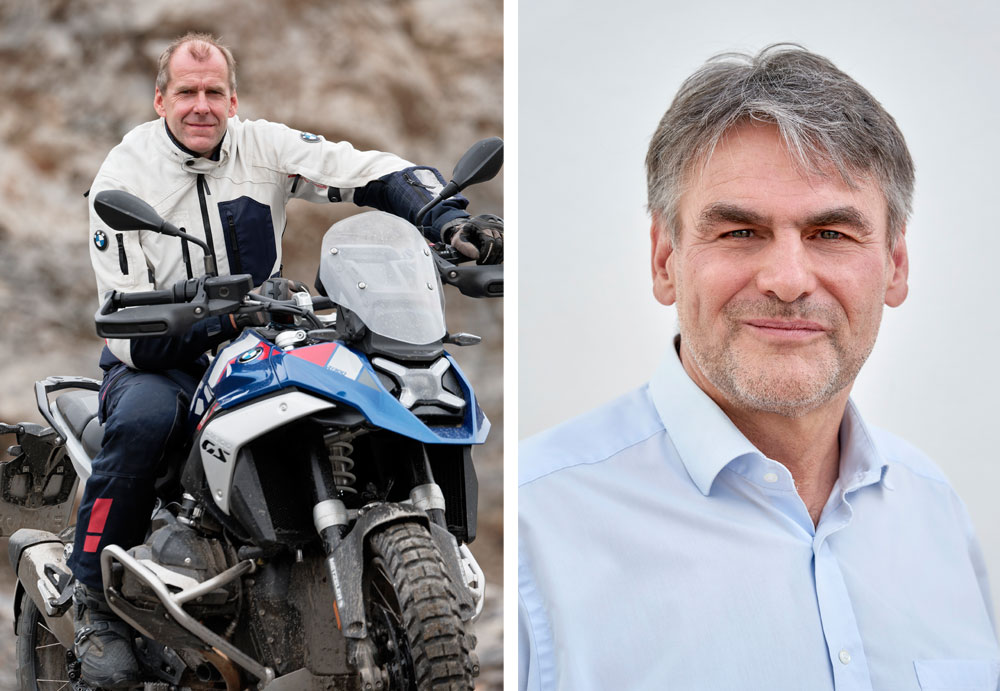
BMW is claiming 145 horsepower and 109 lb-ft of torque from the new air/liquid-cooled motor thanks to wider bore and shorter stroke numbers compared to the 1250 (106.5 x 73mm vs. the 1250’s 102.5 x 76mm). Handily, 95 lb-ft of torque is available from 3600 to 7800 rpm. As expected, the GS runs the ShiftCam unit that varies the valve timing and valve stroke on the intake side. The system runs a single-section intake shift camshaft, which has a partial-load and a full-load cam for each valve to be actuated, each with a different cam geometry.
The intake cams for the left- and right-hand intake valves of the partial-load cam differ in stroke and position. This phase shift means the two intake valves are opened to different degrees on a time-staggered (rpm) basis. The power increase is also the result of a reworked intake system and larger intake and exhaust valves in the cylinder heads, measuring 44mm instead of 40mm on the inlet side and 35.6mm instead of 34mm on the outlet side.
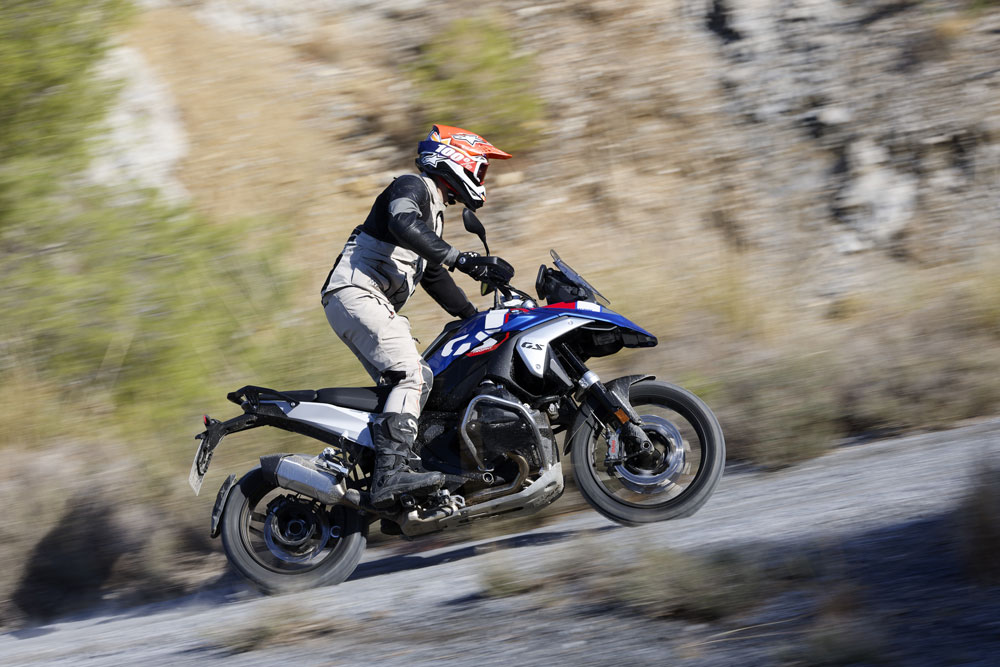
Moving onto the electronics—at least the ones that actually mean something to the riders—BMW has fitted four riding modes: Rain, Road, Enduro and Eco, the last of which allows maximum fuel range to be attained at the (vastly) reduced torque output of the motor.
Should you (and likely you will) go for the additional Ride Modes Pro at the dealership, you’ll get access to Dynamic, Dynamic Pro and Enduro Pro modes that allow for varying levels of throttle response as well as let you lock the back-end and drift into corners on dirt.
Another electronic factor riders should take note of is BMW’s ubiquitous Motor Slip Regulation (MSR)/Drag Torque Control that works by slightly opening the throttle bodies to reduce the chances of the rear wheel locking up under quick deceleration—think of it as a partner to the slipper clutch.

A Shocking Case of Events | 2024 BMW R 1300 GS Review
Although there are many notable improvements to the GS platform, the one the designers are arguably more pleased about than the motor is the new suspension layout. BMW’s front Telelever suspension has been a facet of the bike’s construction for years, but this is the first time we’ve seen a full-house revision as well as what BMW calls variable front spring rates. Huh? You’d have to have two springs to have variable spring rates. Well, BMW does. More on that in a tick.
Using lessons from the HP2 Sport street bike, the new Evo Telelever’s upper fork bridge is clamped tightly to the fork tubes as before but is pivotally and rotatably connected via a radial swivel bearing to a steering shaft tube. This is then guided in the main frame via a cylindrical roller bearing at the top and a deep groove ball bearing at the bottom.
The Evo Telelever has done away with two ball joints, and in place is a flex plate, making for a more ridged front end but one that has far less friction transmitted through the steering.
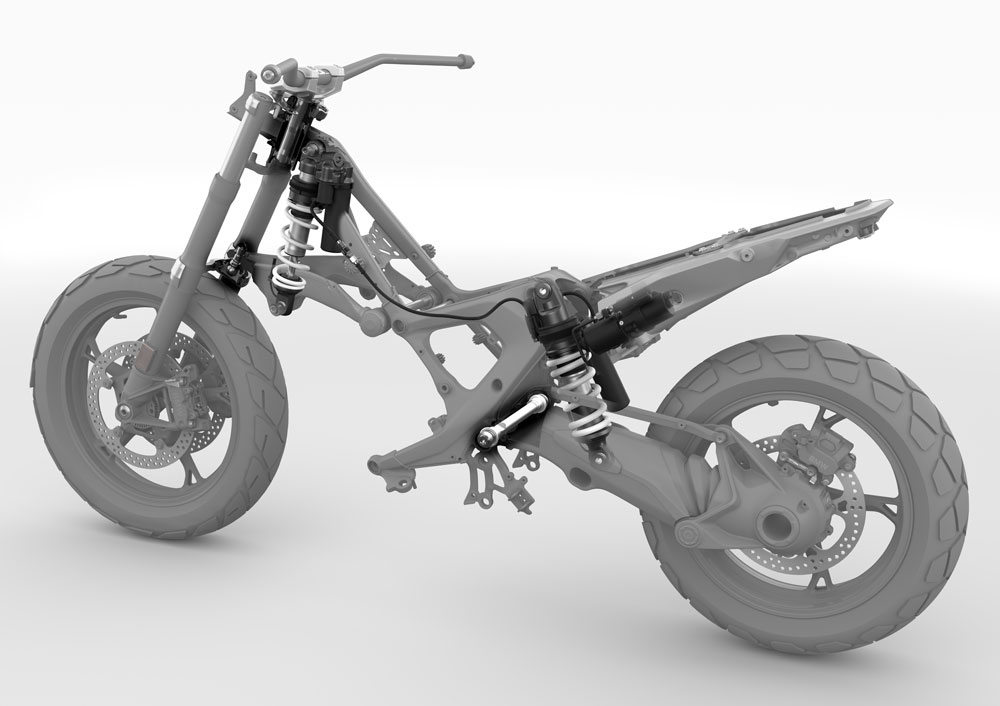
“That’s the reason it’s stiffer, because we can clamp the upper part of the fork more rigidly,” says Reiner Fings, Product Manager of BMW Boxer Models. “You can clamp it, so it’s more precise. At the same time, you reduce the friction. That’s why we have more feedback and a more finer response of the steering inputs.”
BMW’s Evo Telelever doesn’t just rely on a steel plate doing away with ball joints. The company has been developing electronic suspension long before anyone else, even if they have fallen behind specialist suspension companies like Ohlins in recent years, so GS 2024 aims to rectify that.
Damping was traditionally the main factor that could be altered with BMW’s systems. However, the new front shock (yes, front shock) in the Evo Telelever contains a smaller spring within the reservoir, unlocking the holy grail for BMW’s suspension boffins—variable spring rate.
“Before, when you’ve got only one spring rate, it’s always a compromise,” says Christoph Lischka, Head of BMW Motorrad Development. “Now we have two. We have one spring for comfort and one for dynamics. You shift or change your riding mode to feel directly from the chassis. You don’t just switch it between the damping itself anymore, like changing from Road to Dynamic mode.
“Just changing the damping, you are very limited in what you can do. You cannot do it too much because then the damping doesn’t fit to the spring rate anymore. They must fit together. Now, we can change the spring rate. It’s like a dream for me. From the technical side, for example, when you are riding sport style and you do a suspension setting, you always have to change the spring and it’s a lot of work. So for me, this new system is like a dream to change the spring rate.”
The Evo Telelever is complemented by the Evo Paralever, which BMW says has a significantly stiffer connection to the chassis for better traction. Also, the swingarm bearing is arranged off-axis to the axis of rotation of the cardan shaft joint, while the arm itself is longer, thanks to the reduced engine length.
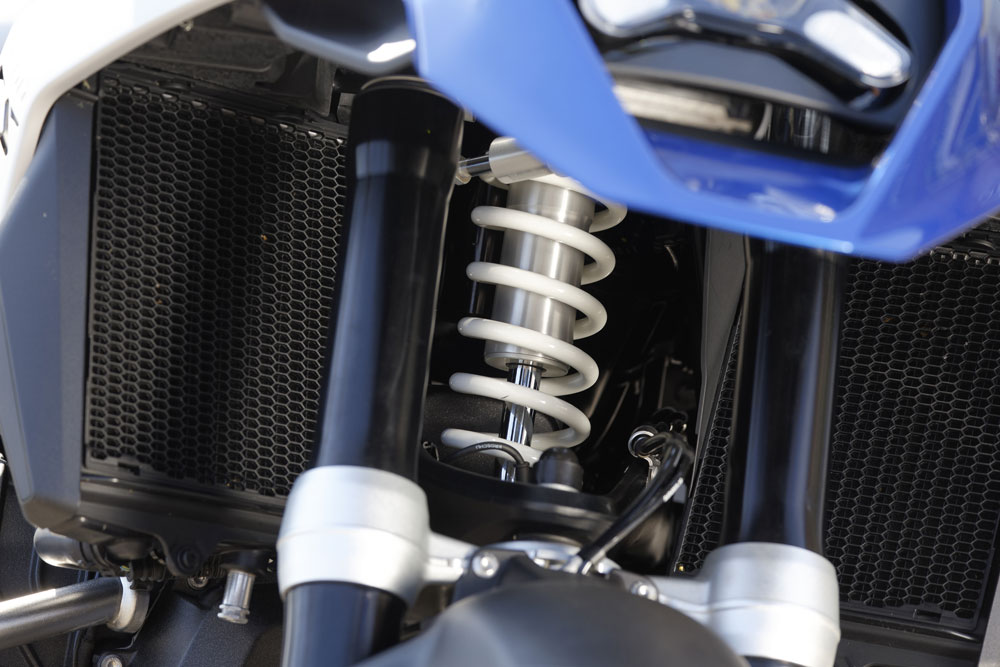
The suspension is matched to a new Dynamic ESA as an optional extra (you can bet pretty much all GSs sold at the dealership will come fitted with Dynamic ESA). It still runs in the rider/rider with luggage/two riders/two riders with luggage parameters but allows the spring rate to be adjustable depending on riding mode—at this stage, I highly recommend you look at the Riding Matrix graph. It’ll explain it much better than I can. Adaptive vehicle height control and sports suspension are available as optional equipment.
In all this, I almost forgot the chassis. This is a new design using a sheet metal main frame and cast aluminum subframe, marking a huge departure from the tubular steel subframe design seen on generations of GS’s. The main frame is much slimmer, lighter and more tightly wrapped around the new motor, although BMW says the front and rear weight distribution is the same as the 1250’s, which itself had excellent high- and low-speed stability.
Braking and Ergo Matters | 2024 BMW R 1300 GS Review
On the subject of slowing down, the GS gets Integral ABS Pro and Dynamic Brake Pro as standard equipment alongside new four-piston radially-mounted calipers up front and a two-piston floating caliper on the rear.
Integral ABS Pro activates the front and rear brakes regardless of whether it’s just the front brake lever that’s pulled. The new system allows for front brake pressure to be applied even if the front lever is never touched, and it’s developed for both on and off-road use depending on the riding mode. When off road, you can lock up the rear wheel if you want.
Dynamic Brake Control is different in that it prevents unintentional throttle application when braking. This happens by reducing the reverse torque that gets to the rear wheel, allowing the brakes to do their job better without the rear wheel chattering (this system works in conjunction with the aforementioned MSR).
Depending on your trim pick, there are three different wheel sets you can get with the GS in 3.0 x 19-inch front and 4.5 x 17-inch rear sizes. The Triple Black model has light, cast aluminum wheels, while the Trophy and Option 719 Tramuntana models come with cross-spoke wheels featuring aluminum rim rings for dedicated off-road use. On top of that, there are new Enduro forged wheels as an accessory that save 3.97 lb of unsprung weight.
As for the rider triangle, there are plenty of options for seat and handlebar heights, different height footrests, levers, grips, you name it.
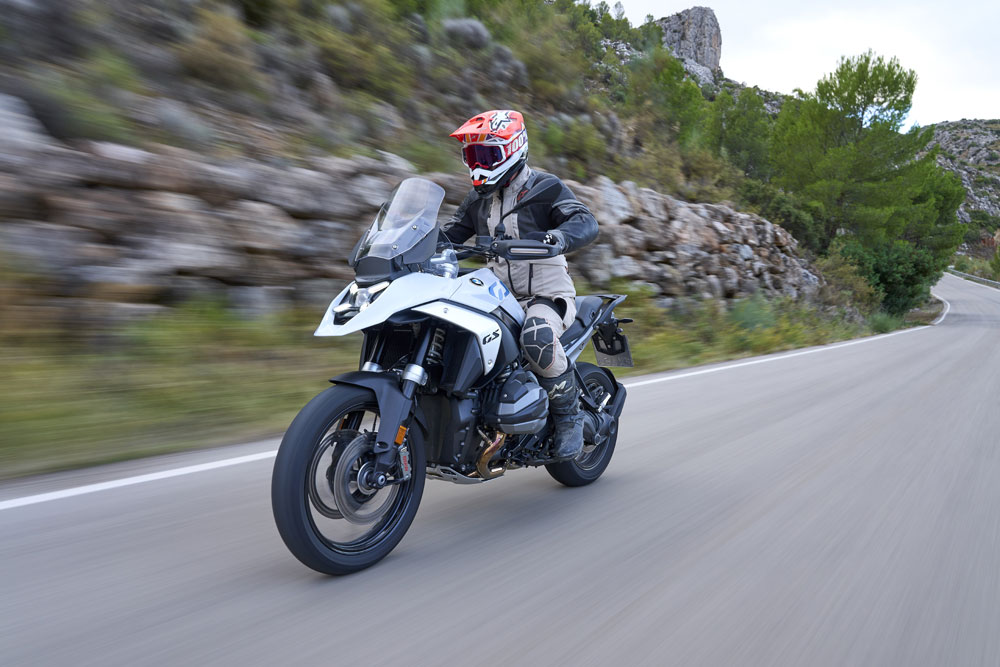
On Road Testing | 2024 BMW R 1300 GS Review
Many—not all—of BMW GS’s sold never see a dirt road in their lives, so on-road performance is as important, if not more, than its off-road capabilities.
At first sit, the cockpit is roomy but more compact than on the 1250—the frontal area is vastly reduced, and the small electronic screen offers a different view from what I’ve traditionally become used to.
The cockpit’s revised switch layout takes a bit to get used to as most of the electronic adjustments happen within the “hamburger” button on the left, such as a heated seat and grips, screen adjustment, traction control and vehicle vitals, but after a few hours on board, I can see the engineer’s line of thinking.
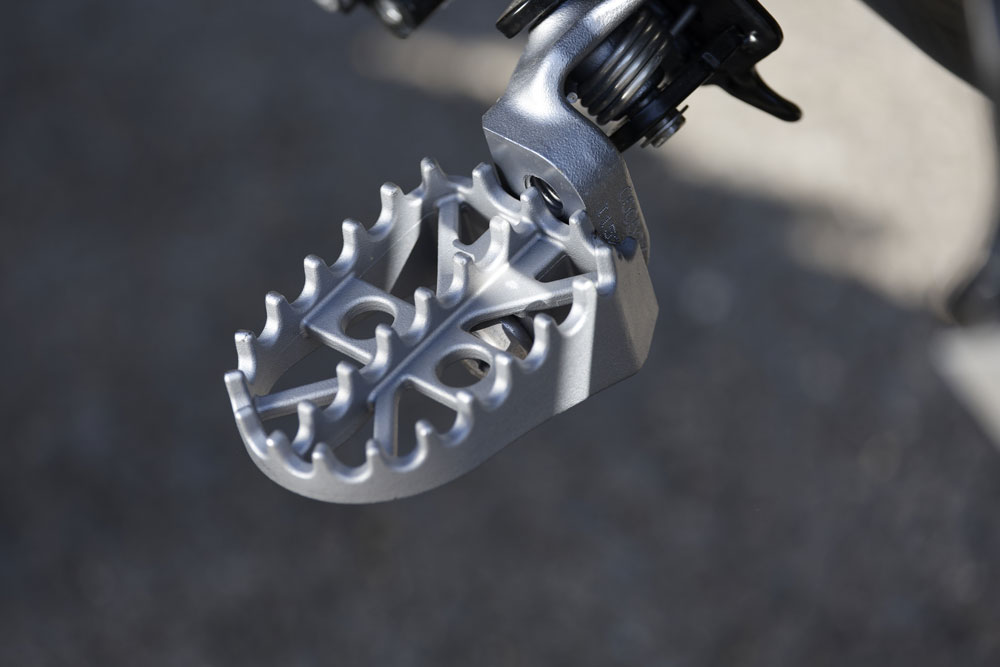
Fire it up, and the engine has a somewhat hollow sound via the new muffler, but the first indication of the motor and gearbox being substantially different is when you snick second gear after take-off. BMW has fitted the gearbox with a sensor signal transmitter for the optional Shift Assistant Pro, resulting in a splendidly smooth gear change, up or down.
The new motor has substantially more balls than the old one, especially through the midrange, where you can lash the throttle on, and it leaps forward without producing anywhere close to the vibrations the old one does.
A quick play around with the modes gives markedly different performance levels, but Eco mode is economical. It feels almost like 30 percent has been taken out of the motor and is best used only for freeway jaunts where overtaking is unnecessary.
The chassis feels longer and lower to the ground, even though you have the same wheelbase as the 1250 at 59.7 inches. The difference in feel comes not in the measurement of front to rear but in the ergonomics, where the new cockpit has you sitting in it rather than on top like the 1250’s.
Braking performance from the Brembo (even though they are badged BMW) calipers is excellent. Combined with MSR, the Dynamic Brake Control and the Integral ABS, you have to try very hard to crash this thing under brakes—not saying you can’t, but you get the idea. The brake and clutch levers are slim little numbers and almost feel like they belong on an M 1000 RR, but the relationship between the master-cylinder and what you get at the caliper is nearly spot on.
On the road, I admit to not finding a massive difference between the old ball-joint Telelever and this new Evo setup. However, that’s just in overall feel at the handlebars. The system is superbly smooth, and the suspension adjustment via the dash does give multiple bike personalities in one. You can go from near supermoto stiffness to a touring bike at the push of a button, more so than you could with the old 1250.
Under acceleration, the new rear suspension and longer swingarm ensure you get every ounce of performance you ask for. The chassis tracks so smoothly when you lay the power down on the street—it’s hard not to have a massive smile on your face when you open up the 1300.
The suspension isn’t perfect, however. I did manage to bottom it out a couple of times while cranked over going up sweeping corners, so there’s still a bit of room for improvement. Overall, however, the ride quality is outstanding and hard to fault.
VIDEO | 5 Things We Love About The 2024 BMW R 1300 GS
Off-Road Testing | 2024 BMW R 1300 GS Review
The fact that the GS has shrunk so much has given it a decided edge over its predecessor when it comes to off-road performance.
The GS’s new ergonomics make low-speed, rough terrain easier to navigate, but by far, the biggest advantage of the 2024 GS is the action and feel of the new Evo Telelever suspension.
On the tarmac, while good, the Evo Telelever isn’t as great a standout as it is when the road gets dirty. Our off-road loop wasn’t so much a loop as it was a course set up by BMW in an old, disused mine with plenty of sharp-edged rocks ready to catch you out. Using Metzeler’s exceptional Karoo 4 ADV tire, the GS’s new front end made life in the rocks a cinch. The machine tracks much better than it did in 2023 and before while still giving loads of feel through the handlebars.
BMW has separated the forces generated from the Evo Telelever so they don’t reach the handlebars as much—the result is a genuinely easy machine to manhandle in tight off-road sections, as well as off-camber dirt roads that would normally have the front-end going walkabout.
Playing around with the ECU modes is an absolute must in off-road conditions, as you want to avoid the full whack of the motor delivered when terrain isn’t at its best. Enduro Pro mode, with its softer throttle response and plusher suspension, made for a stable ride, one that is so approachable that people with far fewer hours in ADV settings than me could hop on and ride confidently.
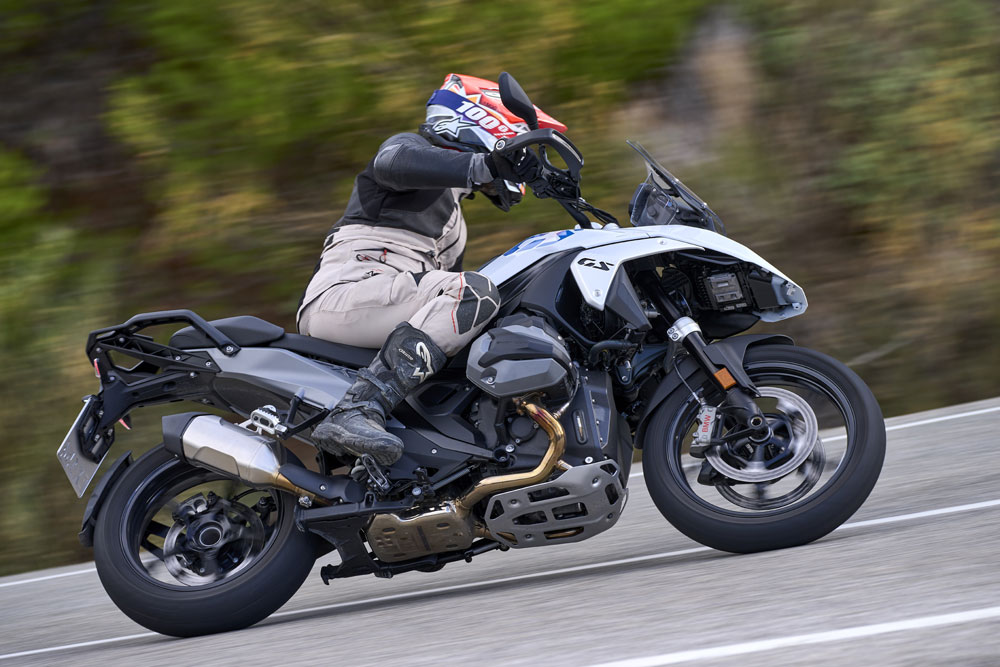
The longer swingarm also made for more stable acceleration and handling on the dirt, especially when the traction control was backed off somewhat. I flicked the TC off for a bit just to feel the mechanical advantages of the chassis unmolested by electronic intervention; again, the result was a very confidence-inspiring ride. The way BMW has mapped the engine’s torque should be commended for slow off-road use. The torque comes on creamy smooth with hardly a hint of throttle or driveline lash from the driveshaft, and when matched to the slick, near-electronic gearshift, the GS is exceptionally hard to fault off-road.
Our time in the off-road loop was short compared to that of the tarmac, but it nonetheless highlighted how vast an improvement the new GS is over the old one—which was and is an excellent motorcycle.
BMW has reinvented the GS for a new generation, making this one of the most impressive bikes of the year. CN
VIDEO | The 2024 BMW R 1300 GS
2024 BMW R 1300 GS
Here’s a brief overview of what each GS model will come with.
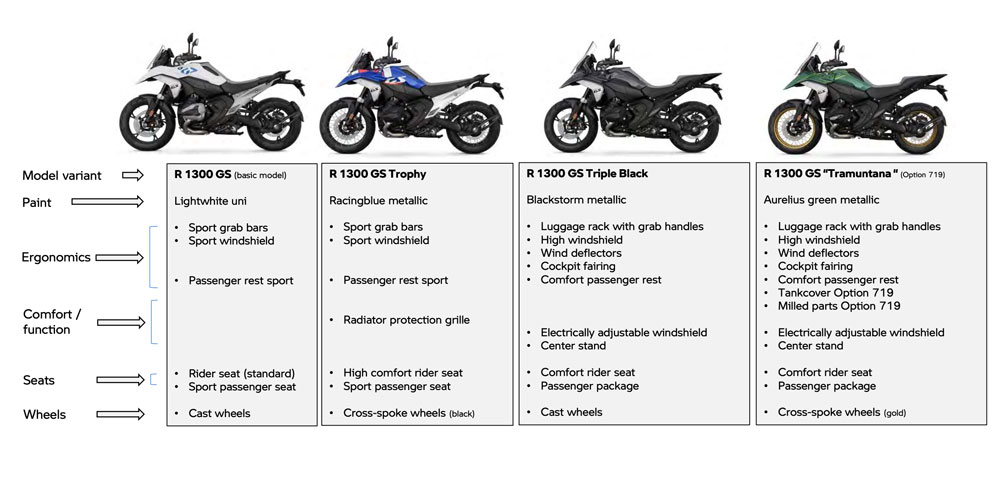
2024 BMW R 1300 GS Model Variant MSRP
Basic model: $19,590
GS Trophy: $20,656
Triple Black: $20,656
“Tramuntana:” $23,285
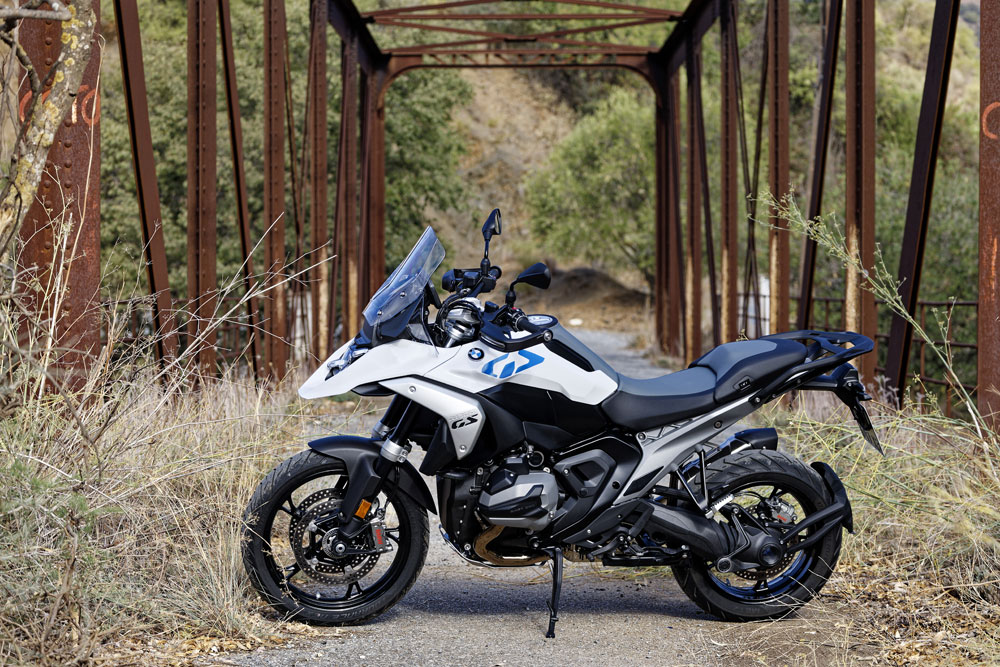
2024 BMW R 1300 GS Specifications
| MSRP: | $19,890 |
| Engine: | Twin-cylinder, 4-stroke Boxer engine |
| Valvetrain: | 2 overhead, chain-driven camshafts, a counterbalance shaft, and variable intake camshaft control system BMW ShiftCam |
| Cooling system: | Air/liquid-cooled |
| Displacement: | 1300cc |
| Bore x stroke: | 106.5 x 73mm |
| Fuel injection: | Electronic fuel injection system, 52mm throttle bodies, Ride-by-Wire throttle |
| Compression ratio: | 13.3:1 |
| Exhaust: | 2-2-1 |
| Transmission: | 6-speed |
| Clutch: | Wet clutch with anti-hopping function, hydraulically activated |
| Chassis: | Two-section frame concept consisting of main frame with bolt-on rear frame, load-bearing engine |
| Front suspension: | EVO Telelever, central suspension strut. Optional equipment: Dynamic ESA |
| Rear suspension: | Cast aluminum single-sided swinging arm with BMW Motorrad EVO Paralever II, WAD spring strut, spring preload hydraulically infinitely adjustable; optional equipment: Dynamic ESA |
| Front-wheel travel: | 7.48 in. |
| Rear-wheel travel: | 7.87 in. |
| Front brake: | Dual semi-floating 310mm discs, 4-piston radial calipers, Cornering ABS |
| Rear brake: | Single 285mm disc, 2-piston floating caliper, Cornering ABS |
| Front tire: | 120/70 R 19 in. |
| Rear tire: | 170/60 R 17 in. |
| Steering head angle: | 63.8° |
| Trail: | 4.41 in. |
| Wheelbase: | 59.7 in. |
| Seat height: | 33.4 in. |
| Fuel capacity: | 5.02 gal. |
| Weight (curb): | 522 lbs. |
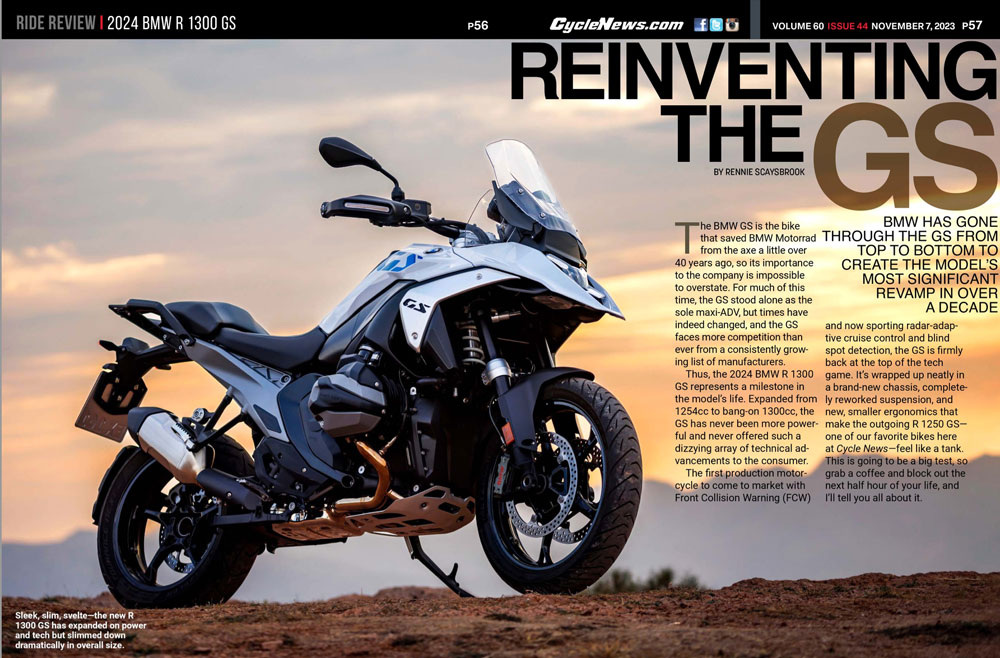
Click here to read the 2024 BMW R 1300 GS Review in the Cycle News Digital Edition Magazine.
Click here for the latest Cycle News Adventure motorcycle reviews and news.
Click here for more BMW motorcycle reviews and news.
